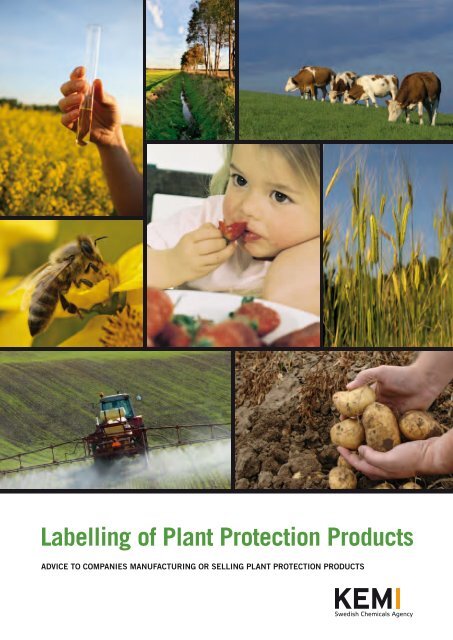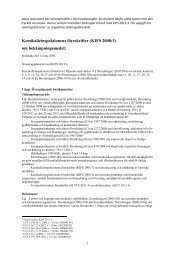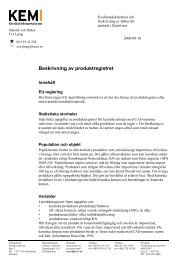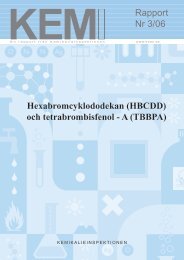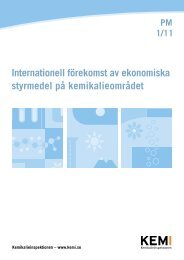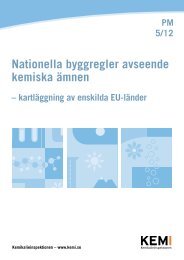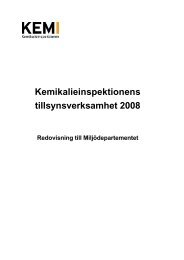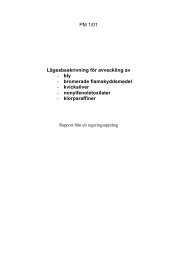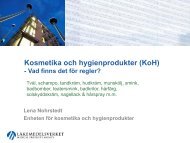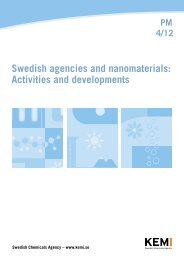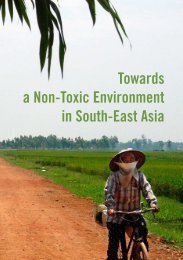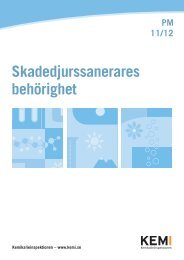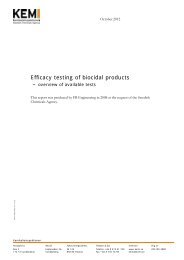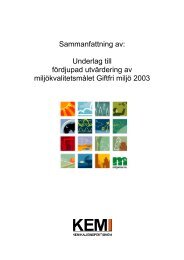Labelling of Plant Protection Products
Labelling of Plant Protection Products
Labelling of Plant Protection Products
You also want an ePaper? Increase the reach of your titles
YUMPU automatically turns print PDFs into web optimized ePapers that Google loves.
<strong>Labelling</strong> <strong>of</strong> <strong>Plant</strong> <strong>Protection</strong> <strong>Products</strong><br />
ADVICE TO COMPANIES MANUFACTURING OR SELLING PLANT PROTECTION PRODUCTS<br />
20
<strong>Labelling</strong><br />
<strong>of</strong> <strong>Plant</strong> <strong>Protection</strong> <strong>Products</strong><br />
ADVICE TO COMPANIES<br />
MANUFACTURING OR SELLING<br />
PLANT PROTECTION PRODUCTS<br />
1
Publisher: Swedish Chemicals Agency©<br />
Order No: 510 955<br />
Order address: Telefax +46 8 50 59 33 99<br />
Phone: +46 8 50 59 33 00, e-mail kemi@cm.se<br />
Pictures: page 10: Eva Orsmark,<br />
page 13: Jens Tønnesen/Dansk Landbruks Medier,<br />
other pages: Ina Agency<br />
Layout: Ingse & Co ab<br />
Print: CM Gruppen, Stockholm 2009<br />
2
Contents<br />
Foreword 5<br />
<strong>Plant</strong> protection products 6<br />
How are humans affected 6<br />
How is environment affected 7<br />
eu rules to reduce risks 7<br />
What can companies do 7<br />
Designing a label 9<br />
Designing directions for use 12<br />
Further information 19<br />
STOB<br />
Fungicide<br />
STOB<br />
company CO<br />
FUNGICIDE<br />
company CO<br />
Product Facts<br />
Product action:<br />
Fungicide<br />
registration number: 1234<br />
authorisation class: 1L<br />
Formulation:<br />
Suspension concentrate (SC)<br />
active substance: 200 g/l (20 weight-% stobstrobin<br />
Pack:<br />
1 litre<br />
conditions oF use<br />
Special conditions must be observed in the use <strong>of</strong> plant protection<br />
products. The conditions are stated in the Swedish Chemical Agency’s<br />
authorisation <strong>of</strong> the product and are based on the risks posed by the<br />
product to health and the environment and good agricultural practice.<br />
Crop Pest Permitted treatment Dose<br />
Time Waiting Max Interval<br />
max<br />
dev. stage period number number<br />
l/ha<br />
days treat. days<br />
Winter<br />
wheat<br />
Spring<br />
wheat<br />
Winter<br />
barley<br />
Spring<br />
barley<br />
Application<br />
method<br />
Fungal DC 30–60 – 2 21–30 1,0 Boom sprayer<br />
Fungal DC 30–60 – 2 21–30 1,0 Boom sprayer<br />
Fungal DC 30–60 – 2 21–30 1,0 Boom sprayer<br />
Fungal DC 30–60 – 2 21–30 1,0 Boom sprayer<br />
Oats Fungal DC 33–61 – 1 – 0,5 Boom sprayer<br />
Triticale Fungal DC 32–61 – 2 21–30 1,0 Boom sprayer<br />
Rye Fungal DC 32–61 – 1 – 0,5 Boom sprayer<br />
Field<br />
beans<br />
Fungal DC 51–65 14*/35* 1 – 0,5 Boom sprayer<br />
* Treatment must not take place less than 14 days prior to harvesting <strong>of</strong> fresh beans with pods, 35 days<br />
prior to harvesting <strong>of</strong> dried beans.<br />
Other conditions<br />
• To limit the risks to aquatic organisms, the instructions contained in<br />
General Advice 97:3 and the assistant for determining wind-adapted<br />
safety distance relating to the Swedish Environmental <strong>Protection</strong><br />
Agency Regulations on the Application <strong>of</strong> Chemical Pesticides<br />
(snfs 1997:2) must be observed.<br />
Reg. No 1234. Authorisation class 1L. For pr<strong>of</strong>essional use only with a special licence.<br />
Approved for control <strong>of</strong> fungal disease in the following crops:<br />
• Winter wheat, spring wheat, winter barley, spring barley, oats, triticale and rye.<br />
• Field beans.<br />
No other use is permitted without a special licence.<br />
Read accompanying instructions before use.<br />
Risk information<br />
Harmful by inhalation. Very toxic to aquatic organisms,<br />
may cause long-term adverse effects in the aquatic environment.<br />
Safety instructions<br />
Keep locked up and out <strong>of</strong> the reach <strong>of</strong> children. Use appropriate container to avoid<br />
environmental contamination. Do not breathe fumes/vapour.<br />
In case <strong>of</strong> insufficient ventilation, wear suitable respiratory equipment.<br />
Wear suitable protective clothing and gloves.<br />
Do not contaminate water with the product or its container.<br />
Do not clean application equipment near surface water.<br />
To avoid the build up resistance do not apply this or any products<br />
containing Qo1 fungicides more than twice per season.<br />
First aid<br />
If swallowed, seek medical advice immediately and show this container or label.<br />
For further information, see safety data sheet.<br />
To avoid risks to humans and the environment, follow the directions for use.<br />
Contents: The product is a suspension concentrate (SC) containing 200 g/l (20 weight-%) stobstrobin.<br />
Batch number: 123 456<br />
Empty packaging: Empty container must not be re-used. Treat this material and its container<br />
as hazardous waste.<br />
Manufacturer/authorisation holder:<br />
Company Co<br />
Box 1, 123 45 TOWN, Phone.: 01-20 30 40<br />
Harmful to health<br />
Harmful to<br />
environment<br />
1 litre<br />
3
Foreword<br />
Sustainable production in agriculture is important in making<br />
it possible to protect the surrounding environment. <strong>Plant</strong><br />
protection products are used in agriculture to prevent pest<br />
organisms and competing plants from causing yield and<br />
quality losses. However, hazardous chemical substances in the<br />
plant protection products may pose risks to humans and the<br />
environment. Rules are therefore required to reduce the risks,<br />
for example by preventing incorrect use.<br />
Companies which manufacture or sell plant protection<br />
products have responsibility for passing on knowledge on<br />
appropriate handling to farmers and other users.<br />
This brochure provides advice on how to design clear and<br />
easy-to-read labels and directions for use. It is aimed at companies<br />
which manufacture or sell or import plant protection products into<br />
Sweden from another country outside the eu or the eea 1 and which<br />
are consequently responsible for the labelling <strong>of</strong> plant<br />
protection products.<br />
1. European Economic Area (eea)<br />
5
<strong>Plant</strong> protection products<br />
In order to protect human health and the environment there are rules<br />
stating that plant protection products must be authorised by the Swedish<br />
Chemicals Agency (KemI) before they may be sold or used. KemI<br />
assesses what risks to health and the environment use <strong>of</strong> the plant<br />
protection product may entail and whether the product is sufficiently<br />
effective.<br />
Even an authorised plant protection product may pose risks to health<br />
and the environment. To reduce the risks there are conditions <strong>of</strong> use,<br />
that is to say special rules to be followed by those who use the<br />
products. The conditions relate for instance to authorisation classes,<br />
exposure risks for the user, residue levels in foods, impacts on birds,<br />
mammals and aquatic organisms and leaching to groundwater and<br />
surface water. The provisions are contained in the <strong>Plant</strong> <strong>Protection</strong><br />
<strong>Products</strong> Ordinance 2 .<br />
How are humans affected<br />
<strong>Plant</strong> protection products contain chemical substances which may be<br />
harmful to human health. The risks depend among other things on the<br />
toxic properties <strong>of</strong> the substances and how people are exposed to them.<br />
People may be exposed to plant protection products, for example through<br />
spillages and splashes on the skin, inhalation <strong>of</strong> spray liquid or accidental<br />
ingestion. Some plant protection products may only be used<br />
pr<strong>of</strong>essionally by persons who hold permits and have received training.<br />
When the hazardousness <strong>of</strong> chemical substances is discussed,<br />
a distinction is made between acutely hazardous and chronically hazardous<br />
substances. The latter are substances that cause harm in long-term<br />
exposure. Examples <strong>of</strong> chronically hazardous substances are those that<br />
can cause cancer, affect the genetic material or interfere with<br />
reproduction. Chemical substances may also cause corrosion, skin<br />
irritation and allergies.<br />
<strong>Plant</strong> protection product residues may occur in food products. To<br />
limit the risks there are rules for residue limits. The National Food<br />
Administration is the authority that tests residue limits in foods.<br />
2. Ordinance (2006:1010) on <strong>Plant</strong> <strong>Protection</strong> <strong>Products</strong>.<br />
6
How is the environment affected<br />
Several <strong>of</strong> the substances used in plant protection products are hazardous<br />
to the environment. This means that they may be difficult to break down<br />
(persistent), accumulate in living organisms or be directly toxic, for<br />
example to aquatic organisms. Persistent substances accumulate in the soil<br />
over several years and in the longer term may have an impact on water<br />
quality. <strong>Plant</strong> protection products may enter watercourses or the groundwater<br />
as a result <strong>of</strong> wind drift, evaporation, surface run<strong>of</strong>f or leaching in<br />
the soil. Residues <strong>of</strong> chemical substances are regularly encountered in<br />
surface water and groundwater. The aim is to reduce unnecessary dispersal<br />
to the environment so that residue levels in surface water and groundwater<br />
are as low as possible.<br />
EU rules to reduce risks<br />
The eu works jointly to improve the rules relating to plant protection<br />
products. An important aim is to reduce the quantity <strong>of</strong> hazardous<br />
chemical substances.<br />
Recent developments<br />
• A new plant protection products regulation has been adopted in the eu<br />
which means, among other things, that hazardous substances have to<br />
be replaced by less hazardous ones.<br />
• The eu’s review programme for plant protection products has meant<br />
that substances <strong>of</strong> very high concern may no longer be used.<br />
• A new directive for sustainable use <strong>of</strong> pesticides 3 has been adopted in<br />
the eu.<br />
• A new regulation on the classification, labelling and packaging <strong>of</strong><br />
substances and mixtures 4 has come into force.<br />
What can companies do<br />
Companies manufacturing or selling plant protection products are<br />
responsible, under current rules, for labelling them correctly. The rules on<br />
labelling are wide-ranging, including special requirements regarding how<br />
the information that reaches the user is to be formulated. The particulars<br />
shown on the label and in the associated directions for use must provide<br />
information on what risks use <strong>of</strong> the product poses and how to protect<br />
oneself against unnecessary or harmful exposure. By designing labels and<br />
directions for use in a clear and easy-to-read way, manufacturers and sellers<br />
<strong>of</strong> plant protection products can assist farmers and other users in reducing<br />
the risks in handling.<br />
3. Directive <strong>of</strong> the European Parliament and <strong>of</strong> the Council 2009/128/ec establishing a framework<br />
for Community action to achieve the sustainable use <strong>of</strong> pesticides.<br />
4. Regulation (ec) No 1272/2008 on classification, labelling and packaging <strong>of</strong> substances and mixtures.<br />
7
!<br />
Make<br />
!<br />
Design<br />
!<br />
!<br />
!<br />
Follow<br />
!<br />
Be<br />
Advice<br />
to manufacturers and sellers <strong>of</strong> plant protection products<br />
sure that the particulars are correct on labels and<br />
directions for use.<br />
the labels uniformly so that the farmer and other users<br />
can find important information quickly and easily.<br />
Position the information which is most important at the start <strong>of</strong><br />
the directions for use.<br />
Use a table format for the description <strong>of</strong> conditions <strong>of</strong> use so that<br />
the farmer and other users can follow the rules more easily.<br />
the main headings in the example directions for use<br />
(see page 12) to make sure that the most important information<br />
is included.<br />
clear about the distinction between rules and instructions in<br />
the directions for use.<br />
To illustrate how the above advice can be used, examples are given in the<br />
next section <strong>of</strong> a label and directions for use. The examples represent<br />
templates on which the design <strong>of</strong> the labelling can be based.<br />
8
Designing a label<br />
The labelling <strong>of</strong> plant protection products must comply with the rules<br />
contained in Annex 1 to the Swedish Chemicals Agency’s Pesticides<br />
Regulations (kifs 2008:3) and the Swedish Chemicals Agency’s<br />
Regulations on Classification and <strong>Labelling</strong> <strong>of</strong> Chemical <strong>Products</strong><br />
(kifs 2005:7) or Regulation (ec) No 1272/2008 on Classification, <strong>Labelling</strong><br />
and Packaging <strong>of</strong> Substances and Mixtures. The provisions contain a full<br />
description <strong>of</strong> how the label is to be designed.<br />
Examples <strong>of</strong> details to appear on a label:<br />
q Trade name.<br />
q Name and address <strong>of</strong> the authorisation holder.<br />
q Where applicable, name and address <strong>of</strong> whoever is responsible for<br />
final labelling.<br />
q Registration number.<br />
q Name and concentration <strong>of</strong> each active substance.<br />
q Net quantity.<br />
q Batch number.<br />
q First-aid details.<br />
q Information to the effect that the packaging must not be re-used if the<br />
product has been classified as very toxic, toxic or harmful to health,<br />
unless the container is specially intended for re-use, reloading or<br />
refilling by the manufacturer or distributor.<br />
q Special rules for humans, animals or the environment, for example<br />
“Contact with vapours causes corrosion <strong>of</strong> skin and eyes” or “Contact<br />
with liquid causes frostbite”.<br />
q Special phrases for the protection <strong>of</strong> humans, animals or the<br />
environment, for example “Do not contaminate water with the<br />
product or its container. Do not clean application equipment near<br />
surface water” or “To protect bees and other pollinating insects do<br />
not apply to crop plants when in flower”.<br />
q Function, for example fungicide, insecticide or herbicide.<br />
q Presentation, for example suspension concentrate, granules or spray<br />
powder.<br />
q Approved use followed by the words “No other use is permitted<br />
without special licence”.<br />
q Instructions on use and dosage.<br />
q Details <strong>of</strong> waiting period.<br />
q Details <strong>of</strong> possible phytotoxicity.<br />
q The words “Read accompanying instructions before use”.<br />
q Instructions on final disposal <strong>of</strong> the plant protection product and<br />
packaging.<br />
q Use-by date (if the shelf life is less than two years).<br />
q The words “To avoid risks to humans and the environment, follow<br />
the directions for use”.<br />
9
q User category and the words “For pr<strong>of</strong>essional use only with special<br />
licence” if the plant protection product belongs to authorisation class<br />
1 or the words “Pr<strong>of</strong>essional use only” if the plant protection product<br />
belongs to authorisation class 2.<br />
q Classification and labelling in accordance with kifs 2005:7 or<br />
Regulation (ec) No 1272/2008.<br />
If there is insufficient space on the packaging, some <strong>of</strong> the information<br />
can be supplied on a separate information sheet which accompanies each<br />
pack. For further details, see Annex 1 to kifs 2008:3.<br />
Points to bear in mind in designing a label<br />
• Place the name <strong>of</strong> the plant protection product at a prominent<br />
location on the label.<br />
• The approved use should be placed at the start <strong>of</strong> the label, but<br />
other conditions <strong>of</strong> use may be placed in the directions for use if<br />
there is insufficient space on the label.<br />
• It is advisable to place risk information, safety instructions and<br />
first-aid details in a frame to make the information clearer.<br />
10
Example <strong>of</strong> the appearance <strong>of</strong> a label<br />
STOB<br />
FUNGICIDE<br />
company CO<br />
Reg. No 1234. Authorisation class 1L. For pr<strong>of</strong>essional use only with a special licence.<br />
Approved for control <strong>of</strong> fungal disease in the following crops:<br />
• Winter wheat, spring wheat, winter barley, spring barley, oats, triticale and rye.<br />
• Field beans.<br />
No other use is permitted without a special licence.<br />
Read accompanying instructions before use.<br />
Risk information<br />
Harmful by inhalation. Very toxic to aquatic organisms,<br />
may cause long-term adverse effects in the aquatic environment.<br />
Safety instructions<br />
Keep locked up and out <strong>of</strong> the reach <strong>of</strong> children. Use appropriate container to avoid<br />
environmental contamination. Do not breathe fumes/vapour.<br />
In case <strong>of</strong> insufficient ventilation, wear suitable respiratory equipment.<br />
Wear suitable protective clothing and gloves.<br />
Do not contaminate water with the product or its container.<br />
Do not clean application equipment near surface water.<br />
To avoid the build up resistance do not apply this or any products<br />
containing Qo1 fungicides more than twice per season.<br />
First aid<br />
If swallowed, seek medical advice immediately and show this container or label.<br />
For further information, see safety data sheet.<br />
Harmful to health<br />
Harmful to<br />
environment<br />
To avoid risks to humans and the environment, follow the directions for use.<br />
Contents: The product is a suspension concentrate (SC) containing 200 g/l (20 weight-%) stobstrobin.<br />
Batch number: 123 456<br />
Empty packaging: Empty container must not be re-used. Treat this material and its container<br />
as hazardous waste.<br />
Manufacturer/authorisation holder:<br />
Company Co<br />
Box 1, 123 45 TOWN, Phone.: 01-20 30 40<br />
1 litre<br />
11
Designing directions for use<br />
Directions for use must contain all important information needed for<br />
suitable handling. The directions must be unique to each individual<br />
product. You should therefore avoid giving too much general<br />
information. Suggestions for possible structuring <strong>of</strong> the directions for use<br />
and for what contents are most relevant for the farmer and other users:<br />
q Product facts<br />
Details <strong>of</strong> the effect <strong>of</strong> the plant protection product, registration<br />
number, authorisation class, active substance etc.<br />
q Conditions <strong>of</strong> use<br />
Description <strong>of</strong> the conditions <strong>of</strong> use that follow the authorisation <strong>of</strong><br />
the plant protection product. There are rules which the user is<br />
obliged to follow, which should also be clearly apparent.<br />
q Restrictions<br />
Information on special instructions in connection with use <strong>of</strong> the<br />
plant protection product. Direct or indirect harmful side-effects on<br />
plants or plant products etc. If there are no restrictions, this should<br />
also be apparent.<br />
q Directions for use<br />
The following headings are proposed so that the user understands the<br />
function <strong>of</strong> the product as well as possible:<br />
Mode <strong>of</strong> action<br />
Description <strong>of</strong> how the product’s mode <strong>of</strong> action influences the<br />
objective <strong>of</strong> treatment. For example, preventive or curative effect,<br />
contact action or systemic action.<br />
Risk <strong>of</strong> resistance<br />
Information on whether there is a risk <strong>of</strong> resistance and a strategy for<br />
avoiding this. Whether the resistance is serious can also be apparent<br />
on the label under “Safety instructions”.<br />
Optimum conditions for action<br />
Information on whether the treatment is affected by wind,<br />
precipitation, temperature, air humidity etc. and how the user can<br />
carry out the most effective treatment. State also rainpro<strong>of</strong>ness.<br />
Dose, quantity <strong>of</strong> water and time <strong>of</strong> treatment<br />
Instructions on what dose is to be used, what quantity <strong>of</strong> water it is<br />
appropriate to use and when treatment has to take place with respect<br />
to infection pressure to obtain optimum treatment.<br />
Application technique<br />
Information on what application equipment is needed and<br />
recommended tractor speed, quantity <strong>of</strong> water, pressure, spray<br />
quality and boom height. In cases where there are conditions for use<br />
<strong>of</strong> drift-reduced equipment this can also be made apparent here.<br />
Refer in the directions for use to the brochure “Assistant for use in<br />
determining wind-adapted safety distance in use <strong>of</strong> an agricultural<br />
12
sprayer with boom”. This brochure can be downloaded from<br />
www.greppa.nu.<br />
Protective equipment<br />
Description <strong>of</strong> personal protective equipment in the various<br />
operations such as filling, treatment and cleaning <strong>of</strong> equipment<br />
taking account <strong>of</strong> what type <strong>of</strong> equipment is used, for example<br />
agricultural sprayer or backpack sprayer.<br />
• Respiratory protection (suitable face mask and filter).<br />
• Hand protection (type <strong>of</strong> material).<br />
• Eye protection (goggles or visor).<br />
• Skin protection (apron, protective shoes or protective suit).<br />
Mixtures<br />
Instructions if the product is physically miscible with other plant<br />
protection products.<br />
Preparation <strong>of</strong> spray liquid<br />
Information on how the agricultural sprayer, backpack sprayer etc.<br />
is to be safely filled.<br />
Cleaning <strong>of</strong> application equipment<br />
Instructions on how application equipment is to be safely cleaned.<br />
Empty packaging<br />
Information on management <strong>of</strong> residues and spillages <strong>of</strong> the plant<br />
protection product and empty packaging; state whether the<br />
residual products can be recycled or whether they have to be treated<br />
as hazardous waste. <strong>Plant</strong> protection products labelled with safety<br />
phrases S56 and S60 are hazardous waste and must not be recycled.<br />
Storage<br />
Description <strong>of</strong> what is specific to the product, for example storage<br />
away from frost.<br />
13
Example <strong>of</strong> appearance <strong>of</strong> directions for use<br />
STOB<br />
FUNGICIDE<br />
company CO<br />
PRODUCT FACTS<br />
Product action: Fungicide<br />
Registration number: 1234<br />
Authorisation class: 1L<br />
Formulation: Suspension concentrate (SC)<br />
Active substance: 200 g/l (20 weight-% stobstrobin<br />
Pack: 1 litre<br />
CONDITIONS OF USE<br />
Special conditions must be observed in the use <strong>of</strong> plant protection<br />
products. The conditions are stated in the Swedish Chemical Agency’s<br />
authorisation <strong>of</strong> the product and are based on the risks posed by the<br />
product to health and the environment and good agricultural practice.<br />
Crop Pest Permitted treatment Dose<br />
Time<br />
max<br />
dev. stage<br />
l/ha<br />
Waiting<br />
period<br />
days<br />
Max<br />
number<br />
treat.<br />
Interval<br />
number<br />
days<br />
Application<br />
method<br />
Winter Fungal DC 30–60 – 2 21–30 1,0 Boom sprayer<br />
wheat<br />
Spring Fungal DC 30–60 – 2 21–30 1,0 Boom sprayer<br />
wheat<br />
Winter Fungal DC 30–60 – 2 21–30 1,0 Boom sprayer<br />
barley<br />
Spring Fungal DC 30–60 – 2 21–30 1,0 Boom sprayer<br />
barley<br />
Oats Fungal DC 33–61 – 1 – 0,5 Boom sprayer<br />
Triticale Fungal DC 32–61 – 2 21–30 1,0 Boom sprayer<br />
Rye Fungal DC 32–61 – 1 – 0,5 Boom sprayer<br />
Field Fungal DC 51–65 14*/35* 1 – 0,5 Boom sprayer<br />
beans<br />
* Treatment must not take place less than 14 days prior to harvesting <strong>of</strong> fresh beans with pods, 35 days<br />
prior to harvesting <strong>of</strong> dried beans.<br />
Other conditions<br />
• To limit the risks to aquatic organisms, the instructions contained in<br />
General Advice 97:3 and the assistant for determining wind-adapted<br />
safety distance relating to the Swedish Environmental <strong>Protection</strong><br />
Agency Regulations on the Application <strong>of</strong> Chemical Pesticides<br />
(snfs 1997:2) must be observed.<br />
14
Note that conditions <strong>of</strong> use and other conditions are statutory<br />
requirements and must be complied with by the person using the<br />
product.<br />
Restrictions<br />
Stob, used in the recommended quantity, has not shown any harmful<br />
effects in trials with cereals and can be regarded as safe to use. There are<br />
no restrictions regarding resowing or subsequent crop.<br />
Directions for use<br />
Mode <strong>of</strong> action<br />
Stob acts systemically (it is carried through the sap flows) in the plant but<br />
also has a translaminar (leaf-penetrating) effect. The product is<br />
principally used for preventive purposes. The best effect is achieved in<br />
direct treatment, that is to say when the first attacks become visible on<br />
the plant. After treatment the plant is protected against fungal attack for<br />
4–6 weeks.<br />
Risk <strong>of</strong> resistance<br />
Resistance is shown by poor or inadequate effect <strong>of</strong> treatment. Stob<br />
contains the active substance stobstrobin, which belongs to the group<br />
<strong>of</strong> Qo1 fungicides (strobilurins). Resistance to strobilurins has been<br />
identified in cereals in mildew and leaf blotch attack in wheat.<br />
Avoid resistance by:<br />
• Using Stob together with other fungicides which do not belong to<br />
the Qo1 group.<br />
• Using Stob preventively or as early as possible when signs <strong>of</strong> attack<br />
appear.<br />
• Use a maximum <strong>of</strong> two treatments <strong>of</strong> Stob per year.<br />
Optimum conditions for action<br />
Treatment should take place when the level <strong>of</strong> fungal attack is low and the<br />
crop is growing well. For optimum action, Stob should be used when the<br />
temperature is 15–18 degrees and the air humidity is over 70 per cent. Avoid<br />
treating in extreme weather conditions, for example during a drought or in<br />
high temperatures (
Dose, quantity <strong>of</strong> water and time <strong>of</strong> treatment<br />
Follow the instructions in the table below. Check the effect <strong>of</strong> the<br />
treatment by leaving an untreated area <strong>of</strong> at least 25 square metres in the<br />
field.<br />
Crop Pest Dose l/ha Quantity <strong>of</strong><br />
water l/ha<br />
Wheat leaf blotch<br />
Winter<br />
wheat/<br />
spring<br />
wheat<br />
Leaf spot<br />
Brown spot<br />
Brown rust<br />
Yellow rust<br />
1,0 l/ha or<br />
(2*0,5)<br />
Time<br />
dev. stage<br />
200–300 DC 47–59<br />
DC 47–55<br />
DC 47–55<br />
DC 37–59<br />
DC 30-59<br />
Remarks<br />
If there is heavy infection pressure<br />
two treatments may be needed. If so,<br />
use a dose <strong>of</strong> 0.5 l/ha at an interval<br />
<strong>of</strong> 21-30 days. The first treatment is<br />
done in DC 37-39 and the second in<br />
DC 55-59.<br />
Winter<br />
barley/<br />
spring<br />
barley<br />
Leaf spot<br />
Leaf blotch<br />
Barley brown rust<br />
1,0 l/ha or<br />
(2*0,5)<br />
200–300 DC 37–39<br />
DC 37–39<br />
DC 30–59<br />
In the event <strong>of</strong> early and heavy attacks<br />
it is appropriate to treat twice.<br />
If doing so, use the lower dose <strong>of</strong> 0.5<br />
l/ha at an interval <strong>of</strong> 21-30 days. The<br />
first treatment is done in DC 31-32<br />
and the second in DC 45-47.<br />
Oats Leaf spot<br />
0,5 l/ha 200–300 DC 37–59 Max. 1 treatment<br />
Brown spot<br />
Triticale Leaf spot<br />
Leaf blotch<br />
Wheat leaf blotch<br />
1,0 l/ha or<br />
(2*0,5)<br />
200–300 DC 37–55<br />
DC 37–55<br />
DC 37–55<br />
In the event <strong>of</strong> early and heavy attacks<br />
it is appropriate to treat twice.<br />
If doing so, use the lower dose <strong>of</strong> 0.5<br />
l/ha at an interval <strong>of</strong> 21-30 days. The<br />
first treatment is done in DC 31-32<br />
and the second in DC 45-47.<br />
Rye Leaf blotch<br />
Leaf spot<br />
Field beans Anthracnose<br />
Chocolate spot<br />
0,5 l/ha 200–300 DC 37–49<br />
DC 37–49<br />
0,5 l/ha 200–300 –<br />
Max. one treatment<br />
Application technique<br />
When using Stob it is important that the spray liquid covers all parts <strong>of</strong><br />
the crop. If growth is vigorous a larger quantity <strong>of</strong> liquid should be used<br />
to provide better coverage. A lower tractor speed also results in better<br />
coverage, as well as larger nozzles that provide an increased quantity <strong>of</strong><br />
liquid.<br />
–<br />
A suitable time for control is at onset<br />
<strong>of</strong> flowering. Max. one treatment.<br />
16
Examples <strong>of</strong> spreaders:<br />
Spreader ISO 110–025 (purple) ISO 110–03 (blue)<br />
Tractor speed 7,5 km/h 7,0 km/h<br />
Quantity <strong>of</strong> water 200 litres 300 litres<br />
Pressure 2,6 bar 2,8 bar<br />
Shower quality Medium Medium<br />
Boom height above crop 40–50 cm 40–50 cm<br />
Spraying must take place under conditions which do not lead to wind drift.<br />
Follow the recommendation in the brochure “Assistant for use in<br />
determining wind-adapted safety distance in use <strong>of</strong> an agricultural sprayer<br />
with boom”. The sprayer must be function-tested and correctly calibrated<br />
to obtain best results.<br />
Protective equipment<br />
The following protective equipment must be used when filling and<br />
cleaning the agricultural sprayer:<br />
• Half-mask with particle filter P2.<br />
• Safety gloves (inner glove <strong>of</strong> latex and outer glove <strong>of</strong> nitrile rubber).<br />
• Visor.<br />
• Protective overalls and protective boots.<br />
Follow general hygiene measures by:<br />
• Avoiding contact with skin, eyes and clothes.<br />
• Refraining from eating, drinking, smoking or taking snuff at the<br />
workplace.<br />
• Removing contaminated clothes.<br />
• Keeping protective equipment separate.<br />
• Washing hands before breaks.<br />
• Showering and washing all clothes at the end <strong>of</strong> the shift.<br />
Mixtures<br />
Stob can be mixed with other plant protection products without<br />
chemical precipitations being formed.<br />
Preparation <strong>of</strong> spray liquid<br />
In fulling tank:<br />
17
• Half-fill with water.<br />
• Follow the recommended dose according to the table.<br />
• Pour the measured dose into the half-filled tank.<br />
• Add any other products and the remainder <strong>of</strong> the water while stirring.<br />
The spray liquid must be stirred in transport and during spraying.<br />
When spray liquid is being prepared no liquid must escape into drains,<br />
rivers or water sources. Use a biobed or a slab with collection.<br />
Cleaning <strong>of</strong> application equipment<br />
Clean the spraying equipment both externally and internally.<br />
Start with internal cleaning <strong>of</strong> the sprayer:<br />
1. Empty the sprayer.<br />
2. Then add a third <strong>of</strong> the contents <strong>of</strong> the rinsing water tank and rinse<br />
the sprayer.<br />
3. Spray the used rinsing water out onto the crop.<br />
4. Refill with another third <strong>of</strong> the water.<br />
5. Add suitable cleaning product to the second rinsing.<br />
6. Circulate the product and the water in the system and spread out.<br />
7. Refill with the last third <strong>of</strong> the water.<br />
8. Circulate the liquid in the system and spread out.<br />
Continue with external cleaning <strong>of</strong> sprayer and tractor. Clean spraying<br />
equipment immediately after use to reduce the risk <strong>of</strong> left-over residues<br />
<strong>of</strong> other products. <strong>Products</strong> not intended to be used for certain crops<br />
may cause damage and reduced yields.<br />
Empty packaging<br />
Empty container must not be re-used. Product residues and used<br />
packaging are hazardous waste and must be sent for destruction. Contact<br />
the local authority environmental and health protection department for<br />
information on waste management.<br />
Storage<br />
Store the product in a dry and cool place away from frost in order to<br />
maintain its stability as well as possible.<br />
18
Further information<br />
the swedish chemicals agency is responsible among other things for<br />
the authorisation <strong>of</strong> plant protection products and rules on classification,<br />
labelling and packaging. Read more on the Swedish Chemicals Agency<br />
website: www.kemi.se<br />
the swedish environmental protection agency is responsible among<br />
other things for reducing the impact on the natural<br />
environment <strong>of</strong> the use and application <strong>of</strong> plant protection<br />
products, as well as waste issues.<br />
Read more on the Swedish Environmental <strong>Protection</strong> Agency website:<br />
www.naturvardsverket.se<br />
the swedish board <strong>of</strong> agriculture’s crop protection centres <strong>of</strong>fer<br />
advice on weeds, fungal diseases, pests etc. Read more on the Swedish<br />
Board <strong>of</strong> Agriculture website: www.jordbruksverket.se<br />
the national food administration is responsible for food safety and<br />
among other things checks limits for pesticide levels in foods.<br />
Read more on the National Food Administration website:<br />
www.livsmedelsverket.se<br />
the swedish work environment authority works for the right to healthy,<br />
safe and stimulating working conditions and among other things is<br />
concerned with protective equipment in the use <strong>of</strong> plant protection products.<br />
Read more on the Swedish Work Environment Authority website: www.<br />
arbetsmiljoverket.se<br />
the swedish crop protection association is an industry<br />
organisation which works to ensure safe use <strong>of</strong> plant protection products.<br />
Read more on the Swedish Crop <strong>Protection</strong> Association<br />
website: www.svensktvaxtskydd.se.<br />
greppa växtskyddet (Focus on <strong>Plant</strong> <strong>Protection</strong>) is an<br />
information and training campaign aimed at improving the<br />
management <strong>of</strong> plant protection products in Swedish agriculture.<br />
Read more on the Focus on <strong>Plant</strong> <strong>Protection</strong> website:<br />
www.greppa.nu<br />
19
Esplanaden 3A, Box 2<br />
SE-172 13 Sundbyberg<br />
22<br />
www.kemi.se


